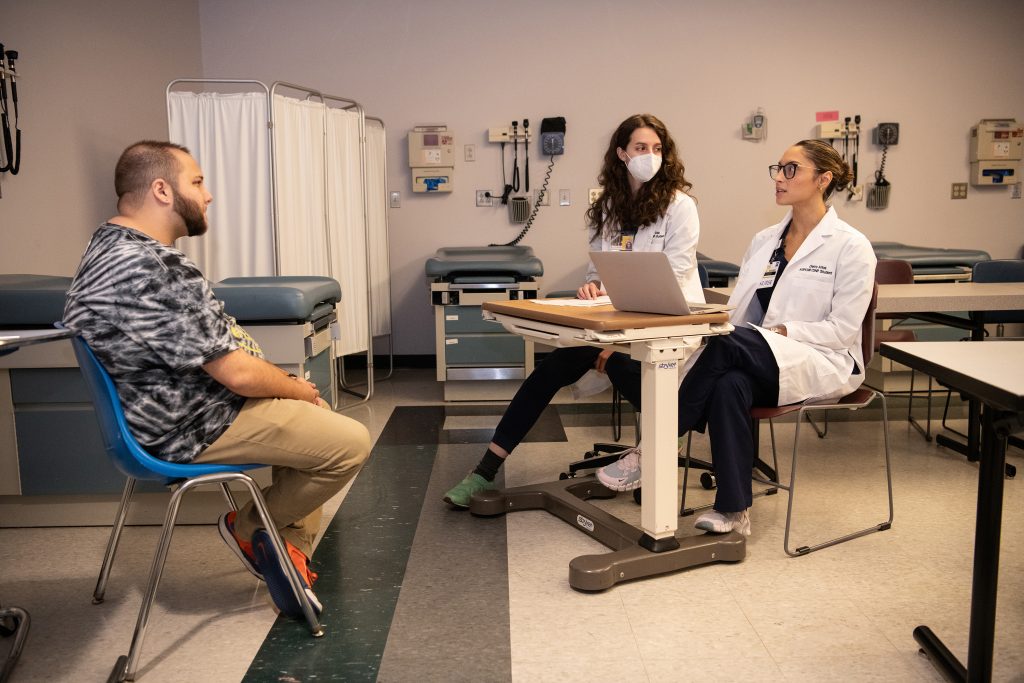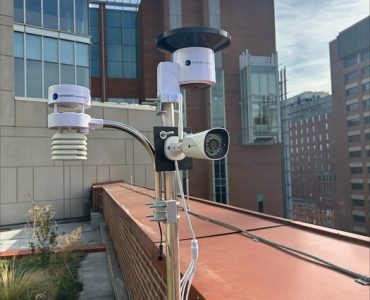
Kade Randall didn’t set out to spend his time training the next generation of medical professionals.
Randall, who works in the cannabis industry, has a background in employee development and experience providing work-related feedback.
And as a trans man, Randall knows firsthand what a bad interaction with medical professionals feels like.
After learning about the Standardized Patient (SP) program at the University of Maryland, Baltimore (UMB) — which uses trained “patients” in clinical instruction and assessment with students — Randall is using his unique experience as a trans man whose work experience focuses on teaching others intent versus impact to prepare students for future patient interactions.
“I’m trans in my everyday life. To be able to have these interactions with someone so that someone else doesn’t have to be made uncomfortable during a visit — that was my main motivating factor in working as a standardized patient,” Randall said.
Learning in a Safe Setting
During a formative simulation this fall, Randall worked with Doctor of Nursing Practice (DNP) students to help them better understand how to provide gender-affirming care in a small group setting.
Randall portrayed Kai, a nonbinary patient who was coming in for a pre-operation appointment for knee surgery.
“That simulation was more so specifically directed at using gender-affirming language and using inclusive language,” Randall said. “So it [gave] them an opportunity to get more associated with terms that may come up during consults with patients who are not generally cisgender-identifying.”
Cierra Arias, a second-year student in the adult-geriatric primary care DNP program, worked with Randall in the simulation. Arias, who hopes to become a palliative care provider with a focus on end-of-life care, said the goal of the simulation was for her to inquire about past medical, surgical, and family history; medications and allergies, all while making sure to be conscious of gender-affirming language.
“We received feedback that overall we made the patient feel very comfortable and trusting throughout our extensive interview. We were sure to be respectful and kind when asking invasive, vulnerable questions to our patient,” she said.
And for Arias, who said she hasn’t had as much interaction with those who are nonbinary or transgender, this type of simulation was particularly helpful.
“This felt like a safe place to receive true feedback and practice communication skills to ensure my patients will feel respected and comfortable with me as their provider, no matter how they identify,” she added.
That ability for students to practice patient interactions in a safe and controlled environment is a main goal of these simulation experiences.
The SP program, which is a joint venture between the Univeristy of Maryland schools of medicine and nursing, began in 2001 to keep up with changing accreditation processes, though the concept of this practice has been around since the 1980s, said Nancy Culpepper, MBA, director of the Standardized Patient Program.
“The premise is that adult learners learn well by doing,” Culpepper said. “Experiential learning really helps reinforce the thought process.”
Representing the Community
The University works with over 100 SPs, all of whom have difference backgrounds, Culpepper said. There’s no prerequisite for the position; some SPs have a background in acting and community theater. Others, like Randall, are experienced in providing employee training and feedback.
“The goal is to represent our community at large — patient-wise, demographic-wise,” she added.
Each SP goes through a basic training process to know how to provide feelings-based, nonjudgmental feedback to the students, something Culpepper said takes special skills. In addition to the initial training, SPs get simulation-specific training for every single case they participate in.
“We talk about psychological safety in our field. And that’s really crucial to what we do,” she said. “All participants, both students and SPs, need to feel safe during these simulations — before, during, and after.”
For Randall, getting to work as an SP whose lived experiences can help inform the students’ training is meaningful.
To know these conversations are taking place, Randall added, and that students going into the medical field are working to broaden their knowledge is important.
“It makes me feel hopeful, especially considering everything going on in the world. Sometimes it feels like there’s not really a place for nonbinary and trans and non-cis people,” he said.
New Partnership with Special Olympics
This fall, UMB began a new partnership with Special Olympics Maryland to continue to expand the pool of Standardized Patients (SPs) of different backgrounds. The partnership, which has the goal of collaborating across disciplines to recruit, train, retrain, and effectively utilize people with intellectual and developmental disabilities as SPs, is made possible due to a $25,000 seed grant from the UMB Center for Interprofessional Education.
The idea is to have a select group of SP coaches work with the Special Olympic SPs. Each SP coach and Special Olympic SP will work together in simulations for the students to have the chance to interact with and learn how to treat individuals with disabilities.
“They’d work as a team. Our standardized patient coach would be a family member. And the SP from the Special Olympics would play the patient role,” Culpepper said.
She added that it would allow for a point of view that those with disabilities have often said needs to be addressed. “They’ve expressed to us that they get ignored and all of the conversation is directed toward the family member. And they feel like they’re not in control of their own health care,” she said.



